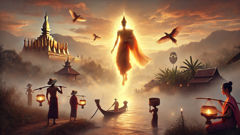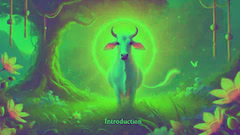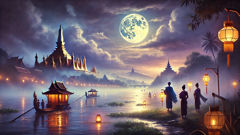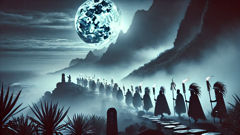Introduction
Beneath the broad sweep of the Mekong sky, where morning rice mist lifts like breath from the earth and limestone ridges hold their quiet watch, the story of a people begins not with a single step but with a descent. The villagers who spoke of Khun Borom spoke in the low, deliberate cadence of those who live by river seasons: a voice that counts floods and harvests, births and funerals. Khun Borom came down from heavens that shone like brass, they said, carried on a ship of clouds and escorted by birds whose feathers flashed like liquid gold. He arrived with knowledge of soil and ceremony, of irrigation channels that would tame wild water and of words that would bind people into a nation. For the Lao, his name is more than mythic figure; Khun Borom is a reservoir of identity, a mirror in which customs, kin, and rulership see themselves reflected. This retelling traces his descent along the Mekong valley, the rites he taught, the law he set, and the branching of his descendants into the many Tai-speaking communities that would later call themselves Lao. It follows the scent of jasmine and incense through villages and terraces, through the courtly halls of a realm formed by river and ridge, and considers how a single origin myth became a living map of belonging. Here is a careful, vivid telling—rooted in landscape, attentive to ritual, generous with detail—that invites readers to walk the banks, feel the mud between their toes, and listen to an ancient story that hums beneath modern Lao life.
Descent and Revelation: Khun Borom Arrives
When the old stories are told in the high season, when the moon is full and offerings are laid out in the lacquered bowls, elders dip their fingers into jasmine-scented water before they begin. They say that before Khun Borom arrived, people lived fragmented lives, tied to small hamlets and the fortunes of single harvests, speaking different dialects and following rituals that were local, private, and varied. The world was hospitable but not yet a polity. Then came the sky-ship and a figure who spoke with the economy of someone who wore winter and summer both: measured words about land and longer words about law. He taught the people how to cut terraces into slopes and to lay bamboo weirs that caught the right moments of the river. He showed them how to coax water from stubborn soil by digging channels that braided like the lines in an old woman’s palm. Those channels, built with hands callused by paddles and hoes, were the first threads of a common life. Here the Mekong was not merely a river of fish and silt; it became an artery connecting villages, a highway of exchange, a seam where stories and seeds met.
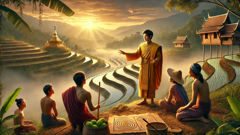
He wore no crown when he came, only a simple cloak patterned like a rice field seen from above. Yet where he walked, stones softened and springs seemed more willing to bubble. He taught ceremonies that threaded the seasons: the offering of glutinous rice to the spirits of the water, the lighting of candles at the temple to call down protection, songs to be sung in chorus at harvest when everyone’s hands were warm with the same labor. Khun Borom’s teachings were practical—how to bind bamboo so boats would not take on water; how to plant one crop to feed a child and another to trade—but they were also symbolic. He placed a post at the heart of a settlement and declared it a center: a place where disputes could be decided and festivals could be held, where the lineage of leaders would be recorded by knot and by story. In doing so he began to bind separate families into a polity. Language became a tool of unity. Those who followed him adapted phrases and metaphors he favored. A phrase for the river that once described only local bend now came to name the whole valley.
Perhaps the most enduring of Khun Borom’s gifts was a kind of ritual grammar: sequences of offering, words spoken at births and burials, the way power was conferred through gestures rather than through brute force. He taught that legitimacy was a chain, a visible passing of authority. A leader could not simply claim the field or the boat; he had to be acknowledged at the post and named in the ritual register, binding him to ancestors and to those who would follow. This idea of ordered succession, of sanctioned rule, allowed communities to imagine a future beyond single seasons. It allowed the planting of orchards that bore fruit for the grandchildren, not merely the child who planted the sapling.
But Khun Borom’s story is not only one of technique and ceremony. It is also an origin of names and directions. When he set down rules of land measurement and the placement of temples, he also taught myths that attached meaning to hills and groves: a particular tree where two lovers met came to be a marker for a boundary; a cave where a widow kept vigil was declared sacred and honored annually. Over time, the landscape was stitched with narrative. People could look at a ridge and recall the story of an ancient pact; they could cross a ford and remember a treaty sealed with an offering of betel. Because of him, the world acquired a memory that was both practical and poetic. The Mekong and its banks were no longer only geography; they were the first pages of a common book that families would open on festival nights and on rainy afternoons to remember who they were and where they came from.
Not all tales agree on the finer points. In some versions Khun Borom arrived alone; in others he was accompanied by a retinue of semi-divine craftsmen and women who taught weaving and metallurgy. Some say he spoke with the voice of thunder, others with a tone like a plucked lute. But in every telling the effect was the same: a reordering of social life, the invention of shared law, and the planting of a seed that would grow into the Lao people. The descent is less a momentary flash than the slow setting of a pattern, a gesture that asks: what is authority if not that which helps people live together? In the hands of those who keep the story, Khun Borom is a teacher, a lawgiver, and a root from which many branches would later grow.
Lineage, Division, and the Many Faces of Lao Identity
Khun Borom’s story grows most complex when the myth must explain division. He did not create a single, immutable state. Rather, the legend often ends with his children or descendants taking different valleys and founding distinct polities. In this way the myth accommodates both the unity of origin and the diversity of later histories. After Khun Borom had taught the arts of rule and agriculture, the narrative goes, he did not remain in one place forever. He married according to the customs he taught, and his children grew and multiplied. Before long a question of inheritance arose—not a quarrel of malice, but a necessary sorting of space. The eldest might take the valley to the east, another the fertile lands by the river’s wide sweep, and another the uplands where cardamom and teak would thrive. Each branch carried a fragment of his teaching, localized by circumstance.
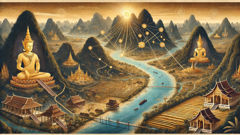
Thus emerges an image both familiar and instructive: a single ancestor whose descendants become founders of separate realms. This is how the Tai-speaking groups that later identified as Lao see continuity. Where archaeology and history show migration, assimilation, and linguistic divergence, the legend provides a map of kinship. When a village in the mountains declares itself a child of Khun Borom, and when a river town does the same, both lay claim to a common origin even while preserving local customs. This dual truth—shared descent and regional adaptation—explains why Lao culture holds a common core of ritual and language across great distances, even as neighboring groups keep distinct songs, dress, and agricultural practice.
The division is narrated with tenderness in the oral tradition. Storytellers emphasize blessings given to each child as he departed, rites performed to ensure his passage, and instructions left behind—keys to governance and to moral code. The eldest might inherit the law of convening at the central post, another the duty of tending river spirits, another the craft of weaving. Each duty defines a civic role that becomes hereditary. Over generations these duties ossify into titles, and titles become the bones of kingdoms and principalities. This is a subtle account of political formation: authority is distributed, not seized; it is anchored in ritual, not merely in conquest.
Conflict arises, of course, as it does in every human narrative. Some descendants rule justly; others press too far. When disputes erupt over land or temple rights, the law that Khun Borom taught is invoked. Elders recall the sequence of gestures he prescribed: the offering of betel, the naming of witnesses, the march to the central post. These practices serve as a ritualized adjudication, a slow-motion courtroom where the community’s memory is called to testify. Even when force edges in, it does so within a framework that honors legitimacy. This creates a culture where power is as much about honor and acknowledgement as it is about arms. In times when neighboring powers pressed on the valley—mountain polities, or later, the encroachments of larger states—the memory of Khun Borom became a rallying point, a story that reframed resistance as defense of a shared order rather than mere stubbornness.
Over centuries, as trade routes shifted and capitals rose and fell, Khun Borom’s name was woven into royal genealogies. Kings would claim descent to legitimize rule; priests and poets would evoke his counsel. Even languages adapt the story: proverbs and idioms bearing his mark sprinkle daily speech. When parents bless a child for good behaviour, they might recall a lesson attributed to Khun Borom about patience and work. When a village stakes out its boundary, elders might recite a phrase of the original land-measuring formula. The legend’s long shadow stabilizes identity through ritual repetition.
Yet the story accommodates growth. New rituals emerge, outsiders are incorporated, and regional gods find places in household shrines. In the twentieth century, as colonial borders sliced through landscapes that once knew only kin, the legend of Khun Borom proved adaptable. People who would become citizens of a modern nation-state looked back to that common ancestor for a story that crossed imposed lines. The past becomes a resource for the present, and the myth becomes political instrument, cultural anchor, and poetic consolation all at once. In this way the tale explains both continuity and change: an origin that allows for plurality, a single river whose tributaries remember their common headwaters even as they flow to different futures.
Conclusion
The Legend of Khun Borom is not an argument about historical facts so much as a living ethic that has helped generations describe who they are and how they should live together. It is a story that turns geography into genealogy and labor into law, teaching that authority must be learned, acknowledged, and repeated through ritual. As modern Laos navigates the pressures of development, migration, and global connections, the myth remains a cultural touchstone—invoked at festivals, inscribed in school lessons, and whispered at hearths. It holds a paradoxical power: both a claim to unity and an allowance for difference. In the quiet hours, when river mist returns and children play along the banks that Khun Borom once walked in song, the legend continues to instruct. It asks communities to remember their roots, to honor the channels that link them, and to find governance in ceremony and kinship. Whether as poetic origin or political charter, Khun Borom endures as a founder who taught both the craft of living and the moral grammar of society. That enduring tale, woven into the Lao landscape and language, keeps the past vivid and the future accountable to a set of shared practices and values. It is a myth that does more than explain origins: it provides a vocabulary for belonging, a set of gestures for reconciliation, and a compass for collective life along the long, patient river.

